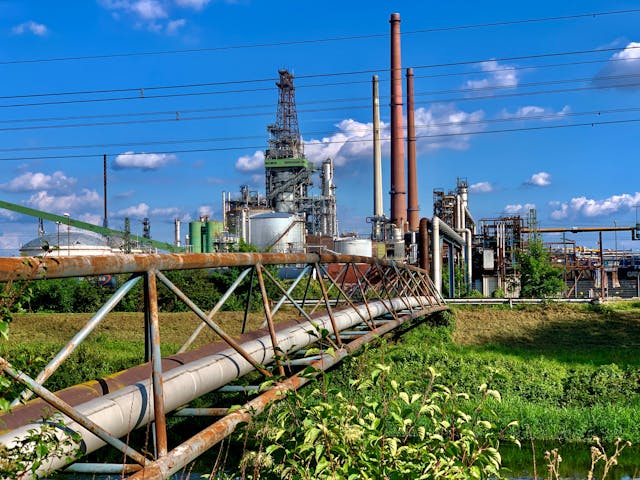
How does an oil pipeline pump oil so far? They use centrifugal pumps to convert rotational energy into the energy that moves a fluid and there are more pumps every 100 km or so.
There are 2,270,526 km of oil pipeline around the world. Not all of that is still in use, but it gives you an idea of how important oil pipelines are. As of writing, there are a further 47,112 km of pipeline that are being constructed and another 143,193 km that have been proposed. This goes to show that we probably won’t be able to get over our dependency on oil anytime soon. The longest pipeline in the world is the Colonial oil pipeline, which is 8,850 km long. The pipeline runs from near Washington DC and down into Texas. It takes approximately 18.5 days for oil to travel the full length of the pipe. 65% of the world’s oil pipelines is in the USA, 8% in Russian, and 3% in Canada. 70% of all the oil the USA produces is transported by pipeline, with the rest going on ships, trucks, or rail.
Oil pipelines were invented pretty much straight after oil was discovered. Oil was discovered in the USA in 1859 and the first oil pipeline was built shortly after that to carry the oil from the oil well to a nearby tanker. There was no existing market or system for oil refining in the very beginning, so there was no need for long pipelines because there was nowhere to send that oil to. Oil was put into barrels and transported on carts, or boats, or trains. That is also the main reason why oil is measured in barrels, even though millions of barrels are produced a day. The oil was pumped out of the ground, piped into a barrel, and then transported to where it needed to go. It was only later that ships that carried the liquid oil in holds were invented and the system changed. The advantages of pipelines over transporting the oil in barrels became clear and towards the end of the 19th century there were far more oil pipelines. The metal used for the pipes gradually improved as well. The majority of pipelines are overland, going over or around obstacles. However, there are also a large number of pipes under the sea. There are approximately 32,000 km of undersea pipelines and many of them are no longer used. It is difficult to get them up, so they are just left where they are. The risk of oil leaks is said to be low, but who knows?
So, how does an oil pipeline pump oil so far? Well, they don’t pump the oil along the entire pipe in one go. The pipes are broken up into stages and each stage will have a pump station that pumps the oil because one pump can only create enough pressure and energy to move the oil for a certain distance. The friction with the pipe, and gravity if the pipe is going uphill, will gradually slow down the oil and mean more pump stations are necessary.
Most of the pumps used are centrifugal pumps. A centrifugal pump has something inside it called an impeller, which looks like a curved propeller. The blades are curved because it needs to push the liquid that travels through it and not cut it up. The impeller spins at between 500 and 5000 revolutions per minute depending on the liquid that they are pushing. The oil is fed into the centrifugal pump at the top. The spinning impeller blades push the oil around very quickly and the oil leaves through a pipe on the other side of the pump. The impellor blades impart kinetic energy to the oil, which forces it to move. The oil also leaves the pump at high speed, being pressed against the oil that is already in the pipe, which increases its pressure. This kinetic energy and high pressure forces the oil that is already in the pipe further along. And this is how the oil can keep moving down the pipe. However, it is not frictionless and the contact with the sides of the pipe, no matter how smooth they are, slows the oil down. The distance the oil can travel depends on the size of the pipe and how much oil is being forced down it. The engineers that make the pipes will calculate this and put another pump at the point where the oil needs to be sped up again. And this is what I learned today.
Photo by orlando s.: https://www.pexels.com/photo/rusty-metal-pipes-with-railings-on-grass-11531870/
Sources
https://www.rigzone.com/training/insight?insight_id=344&c_id=
https://www.iatp.org/sites/default/files/451_2_31375.pdf
https://www.onesteppower.com/post/how-do-oil-pipelines-work
https://en.wikipedia.org/wiki/Centrifugal_pump
https://www.globaldata.com/store/report/oil-and-gas-pipelines-market-analysis
https://en.wikipedia.org/wiki/Colonial_Pipeline
https://pipeline101.org/history-of-pipelines
https://en.wikipedia.org/wiki/History_of_the_petroleum_industry_in_the_United_States

Pingback: What is a zombie virus?